27 found, showing page 2 of 2

Height: 12 feet
Spread: 10 feet
Sunlight: full sun partial shade
Hardiness Zone: 6b
Other Names: Crape Myrtle, Crepe Myrtle
Description:
Covered with pretty papery panicles of pink flowers; attractive exfoliating bark; heat and drought tolerance; does not like to be over-fertilized
Ornamental Features:
Sioux Crapemyrtle is smothered in stunning panicles of pink frilly flowers at the ends of the branches from early to late summer. It has attractive dark green deciduous foliage which emerges coppery-bronze in spring. The oval leaves are highly ornamental and turn orange in fall.
Landscape Attributes:
Sioux Crapemyrtle is a dense multi-stemmed deciduous shrub with an upright spreading habit of growth. Its relatively fine texture sets it apart from other landscape plants with less refined foliage.
This is a relatively low maintenance shrub, and is best pruned in late winter once the threat of extreme cold has passed. Deer don't particularly care for this plant and will usually leave it alone in favor of tastier treats. It has no significant negative characteristics.
Sioux Crapemyrtle is recommended for the following landscape applications:
- Accent
- Mass Planting
- Hedges/Screening
- General Garden Use
- Container Planting
Planting & Growing:
Sioux Crapemyrtle will grow to be about 12 feet tall at maturity, with a spread of 10 feet. It tends to be a little leggy, with a typical clearance of 2 feet from the ground, and is suitable for planting under power lines. It grows at a fast rate, and under ideal conditions can be expected to live for 40 years or more.
This shrub does best in full sun to partial shade. It prefers to grow in average to moist conditions, and shouldn't be allowed to dry out. It is very fussy about its soil conditions and must have rich, acidic soils to ensure success, and is subject to chlorosis (yellowing) of the foliage in alkaline soils. It is highly tolerant of urban pollution and will even thrive in inner city environments. This particular variety is an interspecific
hybrid.
Sioux Crapemyrtle makes a fine choice for the outdoor landscape, but it is also well-suited for use in outdoor pots and containers. Its large size and upright habit of growth lend it for use as a solitary accent, or in a composition surrounded by smaller plants around the base and those that spill over the edges. It is even sizeable enough that it can be grown alone in a suitable container. Note that when grown in a container, it may not perform exactly as indicated on the tag - this is to be expected. Also note that when growing plants in outdoor containers and baskets, they may require more frequent waterings than they would in the yard or garden.
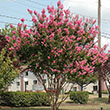
The 'Sioux' is a popular variety known for its large, vibrant-pink, panicle flowers that bloom profusely throughout the summer. This variety will quickly reach 15-20' tall and 12-15' wide. Multi-trunked with a dense, upright growth habit.

The 'Sioux' is a popular variety known for its large, vibrant-pink, panicle flowers that bloom profusely throughout the summer. This variety will quickly reach 15-20' tall and 12-15' wide. Multi-trunked with a dense, upright growth habit.
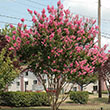
The 'Sioux' is a popular variety known for its large, vibrant-pink, panicle flowers that bloom profusely throughout the summer. This variety will quickly reach 15-20' tall and 12-15' wide. Multi-trunked with a dense, upright growth habit.

The 'Sioux' is a popular variety known for its large, vibrant-pink, panicle flowers that bloom profusely throughout the summer. This variety will quickly reach 15-20' tall and 12-15' wide. Multi-trunked with a dense, upright growth habit.

The 'Waterlily' is known for its double-petaled, fragrant, white blooms that emerge in early spring before foliage emerges. It will reach 15-20' tall and 15-18' wide at maturity. Deciduous.

The 'Whitney Edible' crab apple produces small, sweet fruits that are great for preserving, canning and making cider. Beautiful pinkish-white blossoms will emerge in spring preceding the fruit set that will ripen in late-August or early-September. Mature size is 12-15' tall and wide. Self-pollinating variety, but will benefit from being grouped with pollinators.
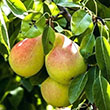
The 'Moonglow' produces large, red-blushed fruit with a soft, juicy texture. Harvest will ripen in mid-September and crop will be more abundant when this tree is paired with other pear varieties, like 'Bartlett' and 'Seckel'. Dwarf variety will get 8-10' tall and wide.
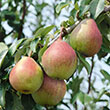
The 'Seckel' produces small, dessert pears that are super sweet with a hint of spice. These sweet, juicy fruits are often used in cooking, canning and fresh eating. This variety gets 15-20' tall and 12-15' wide. Harvest will ripen mid-September.
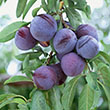
The 'Methley' produces large clusters of sweet, purple-red plums that are great for fresh eating, cooking and preserves. This variety is a heavy producer and is quite disease resistant. Will get 10-12' tall and wide and fruit will ripen in mid-July. Fragrant white flowers emerge in early spring, adding seasonal interest.
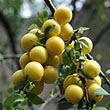
The 'Shiro' produces large clusters of bright yellow plums with a juicy, rich flesh. This variety is a heavy producer, with fruit ripening late-July through mid-August. This variety reaches 12-15' tall and wide, but can be pruned to maintain a smaller size. Does well when pollinated by other varieties, like the 'Redheart' and 'Methley'.
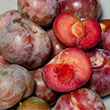
The 'Flavor Supreme' pluot is a plum-apricot hybrid that combines all of the most delicious parts of each fruit. This dwarf variety will average at about 12-15' tall and wide. Juicy, rich fruit will ripen mid-June to early-July. It will bear more fruit when combined with other pluot varieties, as well as late-blooming plums, like the 'Santa Rosa' and 'Burgundy' varieties.
27 found, showing page 2 of 2